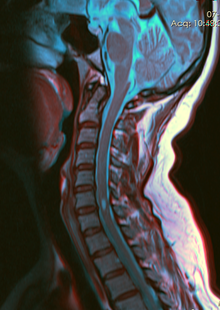WBR1145
| Author | [[PageAuthor::Pratik Bahekar, MBBS [1]]] |
|---|---|
| Exam Type | ExamType::USMLE Step 2 CK |
| Main Category | MainCategory::Internal medicine, MainCategory::Surgery |
| Sub Category | SubCategory::Neurology, SubCategory::Surgery |
| Prompt | [[Prompt::A 39 year old woman was suffering from loss of sensation in the hands, abnormal body sweating, and bowel control issues. She denies a history of trauma, fever, neck rigidity or radiating pain in the arm. On examination pressure, vibration,and touch sensations were intact in the upper extremities. Her symptoms worsened while coughing,and straining. Her cervical MRI is shown below. |
| Answer A | AnswerA::Multiple sclerosis |
| Answer A Explanation | [[AnswerAExp::Incorrect! A person with MS can have almost any neurological symptom or sign; with autonomic, visual, motor, and sensory problems being the most common. The specific symptoms are determined by the locations of the lesions within the nervous system, and may include loss of sensitivity or changes in sensation such as tingling, pins and needles or numbness, muscle weakness, very pronounced reflexes, muscle spasms, or difficulty in moving; difficulties with coordination and balance (ataxia); problems with speech or swallowing, visual problems (nystagmus, optic neuritis or double vision), feeling tired, acute or chronic pain, and bladder and bowel difficulties, among others. Difficulties thinking and emotional problems such as depression or unstable mood are also common. Uhthoff's phenomenon, a worsening of symptoms due to exposure to higher than usual temperatures, and Lhermitte's sign, an electrical sensation that runs down the back when bending the neck, are particularly characteristic of multiple sclerosis.]] |
| Answer B | AnswerB::Syringomyelia |
| Answer B Explanation | [[AnswerBExp::Correct! Syringomyelia causes a wide variety of neuropathic symptoms due to damage of the spinal cord. Patients may experience severe chronic pain, paresthesia and loss of sensation, particularly in the hands. Some patients experience paralysis or paresis temporarily or permanently. A syrinx may also cause disruptions in the parasympathetic and sympathetic nervous system, leading to abnormal body temperature or sweating, bowel control issues, or other problems. If the syrinx is higher up in the spinal cord or affecting the brainstem as in syringobulbia, vocal cord paralysis, ipsilateral tongue wasting, trigeminal nerve sensory loss, and other signs may occur. Classically, syringomyelia spares the dorsal column/medial lemniscus of the spinal cord, leaving pressure, vibration, touch and proprioception intact in the upper extremities. Neuropathic arthropathy, also known as a Charcot joint, can occur, particularly in the shoulders, in patients with syringomyelia. The loss of the sensory fibers to the joint is theorized to lead to damage of the joint over time MRI is used to diagnose syringomyelia and will show the syrinx in the spine or any other conditions, such as the presence of a tumor.]] |
| Answer C | AnswerC::Subacute combined degeneration |
| Answer C Explanation | [[AnswerCExp::Incorrect! The onset of subacute combined degeneration is gradual and uniform. The pathological findings of subacute combined degeneration consist of patchy losses of myelin in the dorsal and lateral columns. Patients present with weakness of legs, arms, trunk, tingling and numbness that progressively worsens. Vision changes and change of mental state may also be present. Bilateral spastic paresis may develop and pressure, vibration and touch sense are diminished. A positive Babinski sign may be seen. Prolonged deficiency of vitamin B12 leads to irreversible nervous system damage.]] |
| Answer D | AnswerD::Anterior spinal artery occlusion |
| Answer D Explanation | [[AnswerDExp::Incorrect! Anterior spinal artery occlusion manifests as,
|
| Answer E | AnswerE::Cervical disc prolapse |
| Answer E Explanation | [[AnswerEExp::Incorrect! Cervical disc herniations occur in the neck, most often between the fifth & sixth (C5/6) and the sixth and seventh (C6/7) cervical vertebral bodies. Symptoms can affect the back of the skull, the neck, shoulder girdle, scapula, shoulder, arm, and hand. The nerves of the cervical plexus and brachial plexus can be affected.]] |
| Right Answer | RightAnswer::B |
| Explanation | [[Explanation::As seen in the given MRI, syringomyelia will show the syrinx in the spine. Educational Objective: |
| Approved | Approved::No |
| Keyword | WBRKeyword::Syringomyelia |
| Linked Question | Linked:: |
| Order in Linked Questions | LinkedOrder:: |
